1/2 >>
Lightflowで立方体生成関数をつくる その1
plasticマテリアルを以下のようにリスト化した
col=[plastic,plastic2,plastic3,plastic4,plastic5,plastic6]
これで、col[0]からcol[5]まで6つのマテリアルが呼び出せる。
Pythonで関数は、def hoge:で書いていく。
Lightflow内のboxの位置とリスト化したマテリアルを引数として渡して、立方体を生成するように以下のように定義した。
#関数定義 ボックスの位置とリストcolのインデックス番号0から5まで
def boxpos(x0,y0,z0,c):
s.materialBegin( col[c] )
s.transformBegin( transform().translation( vector3(x0,y0,z0)))
s.addObject( s.newObject( "box", [ "position",vector3( -1.0, -1.0, -1.0 ),vector3( 1.0, 1.0, 1.0 )] ) )
s.transformEnd()
s.materialEnd()
よって、一行
boxpos(0,0,0,0)
boxpos(-3.0,0,0,1)
boxpos(-3,-3,0,3)
boxpos(0,-3,0,4)
のように記述してあげると良い。
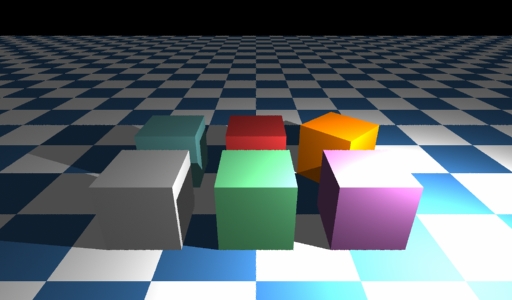
以下はサンプルファイルである。
#! /usr/bin/env python
#box_def.py
from lightflowPM import *
from math import *
import colorinc
s = scene()
s.lightOn( s.newLight( "point", [ "position", vector3( 5.0, -5.0, 4.0 ), "color", vector3( 300.0, 300.0, 300.0 ) ] ) )
s.lightOn( s.newLight( "ambient", [ "color", vector3( 0.3, 0.3, 0.3 ) ] ) ) #環境光を加える。
plastic = s.newMaterial( "standard",[ "kc", colorinc.Brown,"kd",0.66 ] ) #
plastic2 = s.newMaterial( "standard",[ "kc", colorinc.CadetBlue,"kd",0.66 ] ) #
plastic3 = s.newMaterial( "standard",[ "kc", colorinc.Coral,"kd",0.66 ] ) #
plastic4 = s.newMaterial( "standard",[ "kc", colorinc.VLightGray,"kd",0.66 ] ) #
plastic5 = s.newMaterial( "standard",[ "kc", colorinc.Aquamarine,"kd",0.66 ] ) #
plastic6 = s.newMaterial( "standard",[ "kc", colorinc.BlueViolet,"kd",0.66 ] ) #
#plasticをリスト化した
col=[plastic,plastic2,plastic3,plastic4,plastic5,plastic6]
check_ground=s.newPattern("check",["color",vector3( 0.2, 0.4, 0.6 ),"scale",0.025])
ground=s.newMaterial( "standard",[ "kc", check_ground,"kc",vector3( 1.0, 1.0, 1.0 ),"ka",check_ground ] ) #チェック青と白
#関数定義 ボックスの位置とリストcolのインデックス番号0から5まで
def boxpos(x0,y0,z0,c):
s.materialBegin( col[c] )
s.transformBegin( transform().translation( vector3(x0,y0,z0)))
s.addObject( s.newObject( "box", [ "position",vector3( -1.0, -1.0, -1.0 ),vector3( 1.0, 1.0, 1.0 )] ) )
s.transformEnd()
s.materialEnd()
#Brown box
boxpos(0,0,0,0)
#CadetBlue box
boxpos(-3.0,0,0,1)
#Coral box z軸中心に45度回転
s.materialBegin( col[2] )
s.transformBegin( transform().translation( vector3(3.0,0,0)))
s.transformBegin( transform().rotationAroundZ( pi*45.0/180 ))
s.addObject( s.newObject( "box", [ "position",vector3( -1.0, -1.0, -1.0 ),vector3( 1.0, 1.0, 1.0 )] ) )
s.transformEnd()
s.transformEnd()
s.materialEnd()
#VLightGray box
boxpos(-3,-3,0,3)
#Aquamarine box
boxpos(0,-3,0,4)
#BlueViolet box
boxpos(3,-3,0,5)
#check模様の地面groundをpatchで作成しています。高さ(z軸)を-1.0にしてぴったり立方体とあわせています。
s.materialBegin( ground )
s.addObject( s.newObject( "patch", [ "points",vector3( -50, -50, -1.0 ),vector3( -50, 50, -1.0 ),vector3( 50, -50, -1.0 ),vector3( 50, 50, -1.0 )] ) )
s.materialEnd()
saver = s.newImager( "tga-saver", [ "file", "box_def.tga" ] )
s.imagerBegin( saver )
camera = s.newCamera( "pinhole", [ "eye", vector3( 0, -10, 5 ), "aim", vector3( 0, 0, 0 ) ] )
s.imagerEnd()
s.render( camera, 512, 300 )
Lightflowで立方体生成関数をつくる その2
マテリアルを1色にしてみた。
col=[plastic,plastic2,plastic3,plastic4,plastic5,plastic6]
の中から、col[2]を選ぶ。
boxpos(0,0,0,2)
boxpos(-3.0,0,0,2)
boxpos(-3,-3,0,2)
boxpos(0,-3,0,2)
のように記述した。
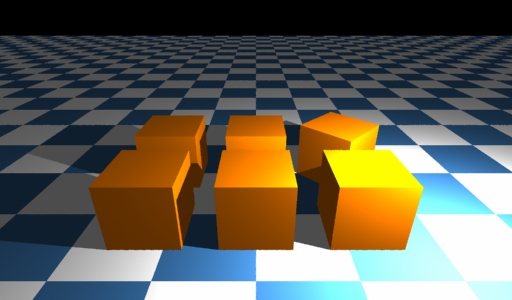
Lightflowで立方体生成関数をつくる その3
立方体を並べてみた。25個並べてみる。色は全部同じ。
#関数定義 ボックスの位置とリストcolのインデックス番号0から5まで
def boxpos(x0,y0,z0,c):
s.materialBegin( col[c] )
s.transformBegin( transform().translation( vector3(x0,y0,z0)))
s.addObject( s.newObject( "box", [ "position",vector3( -1.0, -1.0, -1.0 ),vector3( 1.0, 1.0, 1.0 )] ) )
s.transformEnd()
s.materialEnd()
#Create boxes!! 色は全部同じ
for i in range(-6,7,3):
for k in range(-6,7,3):
boxpos(i,k,0,2)
rangeの部分で-6から6まで3つ飛びで位置を決めている。
試しに、pythonのコマンドラインから
for i in range(-6,7,3):
print i
と入れてどのように動くか試してみるとわかるでしょう。
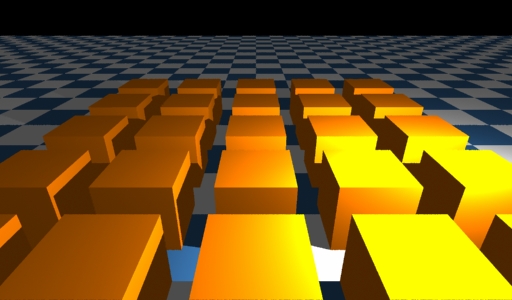
以下は、サンプルファイルである。
#! /usr/bin/env python
from lightflowPM import *
from math import *
import colorinc
s = scene()
s.lightOn( s.newLight( "point", [ "position", vector3( 5.0, -5.0, 4.0 ), "color", vector3( 300.0, 300.0, 300.0 ) ] ) )
s.lightOn( s.newLight( "ambient", [ "color", vector3( 0.3, 0.3, 0.3 ) ] ) ) #環境光を加える。
plastic = s.newMaterial( "standard",[ "kc", colorinc.Brown,"kd",0.66 ] ) #
plastic2 = s.newMaterial( "standard",[ "kc", colorinc.CadetBlue,"kd",0.66 ] ) #
plastic3 = s.newMaterial( "standard",[ "kc", colorinc.Coral,"kd",0.66 ] ) #
plastic4 = s.newMaterial( "standard",[ "kc", colorinc.VLightGray,"kd",0.66 ] ) #
plastic5 = s.newMaterial( "standard",[ "kc", colorinc.Aquamarine,"kd",0.66 ] ) #
plastic6 = s.newMaterial( "standard",[ "kc", colorinc.BlueViolet,"kd",0.66 ] ) #
#plasticをリスト化した
col=[plastic,plastic2,plastic3,plastic4,plastic5,plastic6]
check_ground=s.newPattern("check",["color",vector3( 0.2, 0.4, 0.6 ),"scale",0.025])
ground=s.newMaterial( "standard",[ "kc", check_ground,"kc",vector3( 1.0, 1.0, 1.0 ),"ka",check_ground ] ) #チェック青と白
#関数定義 ボックスの位置とリストcolのインデックス番号0から5まで
def boxpos(x0,y0,z0,c):
s.materialBegin( col[c] )
s.transformBegin( transform().translation( vector3(x0,y0,z0)))
s.addObject( s.newObject( "box", [ "position",vector3( -1.0, -1.0, -1.0 ),vector3( 1.0, 1.0, 1.0 )] ) )
s.transformEnd()
s.materialEnd()
#Create boxes!!
for i in range(-6,7,3):
for k in range(-6,7,3):
boxpos(i,k,0,2)
#check模様の地面groundをpatchで作成しています。高さ(z軸)を-1.0にしてぴったり立方体とあわせています。
s.materialBegin( ground )
s.addObject( s.newObject( "patch", [ "points",vector3( -50, -50, -1.0 ),vector3( -50, 50, -1.0 ),vector3( 50, -50, -1.0 ),vector3( 50, 50, -1.0 )] ) )
s.materialEnd()
saver = s.newImager( "tga-saver", [ "file", "box_def3.tga" ] )
s.imagerBegin( saver )
camera = s.newCamera( "pinhole", [ "eye", vector3( 0, -10, 5 ), "aim", vector3( 0, 0, 0 ) ] )
s.imagerEnd()
s.render( camera, 512, 300 )
Lightflowで立方体生成関数をつくる その4
立方体をさらに並べてみる。25個並べてみる。色も6色順番に表示している。
#Create boxes!!
c=0
cnt=0
for i in range(-6,7,3):
for k in range(-6,7,3):
boxpos(i,k,0,c)
cnt=cnt+1
c=cnt%6
cnt=cnt+1でカウントを行い、c=cnt%6で、6で割った余りが
0から5までになるので、順番に色を決めていくことができる。
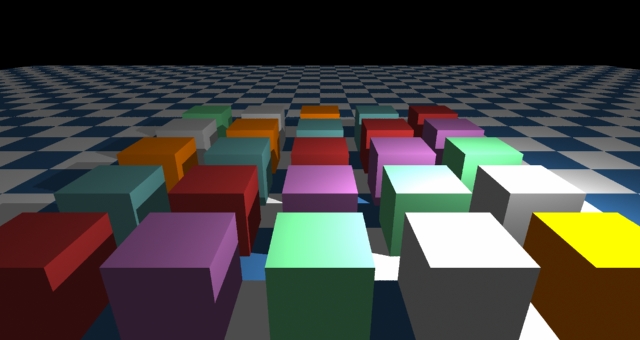
以下は、サンプルファイルである。
#! /usr/bin/env python
from lightflowPM import *
from math import *
import colorinc
s = scene()
s.lightOn( s.newLight( "point", [ "position", vector3( 5.0, -5.0, 6.0 ), "color", vector3( 300.0, 300.0, 300.0 ) ] ) )
s.lightOn( s.newLight( "ambient", [ "color", vector3( 0.3, 0.3, 0.3 ) ] ) ) #環境光を加える。
plastic = s.newMaterial( "standard",[ "kc", colorinc.Brown,"kd",0.66 ] ) #
plastic2 = s.newMaterial( "standard",[ "kc", colorinc.CadetBlue,"kd",0.66 ] ) #
plastic3 = s.newMaterial( "standard",[ "kc", colorinc.Coral,"kd",0.66 ] ) #
plastic4 = s.newMaterial( "standard",[ "kc", colorinc.VLightGray,"kd",0.66 ] ) #
plastic5 = s.newMaterial( "standard",[ "kc", colorinc.Aquamarine,"kd",0.66 ] ) #
plastic6 = s.newMaterial( "standard",[ "kc", colorinc.BlueViolet,"kd",0.66 ] ) #
#plasticをリスト化した
col=[plastic,plastic2,plastic3,plastic4,plastic5,plastic6]
check_ground=s.newPattern("check",["color",vector3( 0.2, 0.4, 0.6 ),"scale",0.025])
ground=s.newMaterial( "standard",[ "kc", check_ground,"kc",vector3( 1.0, 1.0, 1.0 ),"ka",check_ground ] ) #チェック青と白
#関数定義 ボックスの位置とリストcolのインデックス番号0から5まで
def boxpos(x0,y0,z0,c):
s.materialBegin( col[c] )
s.transformBegin( transform().translation( vector3(x0,y0,z0)))
s.addObject( s.newObject( "box", [ "position",vector3( -1.0, -1.0, -1.0 ),vector3( 1.0, 1.0, 1.0 )] ) )
s.transformEnd()
s.materialEnd()
#Create boxes!!
c=0
cnt=0
for i in range(-6,7,3):
for k in range(-6,7,3):
boxpos(i,k,0,c)
cnt=cnt+1
c=cnt%6
#check模様の地面groundをpatchで作成しています。高さ(z軸)を-1.0にしてぴったり立方体とあわせています。
s.materialBegin( ground )
s.addObject( s.newObject( "patch", [ "points",vector3( -50, -50, -1.0 ),vector3( -50, 50, -1.0 ),vector3( 50, -50, -1.0 ),vector3( 50, 50, -1.0 )] ) )
s.materialEnd()
saver = s.newImager( "tga-saver", [ "file", "box_def4.tga" ] )
s.imagerBegin( saver )
camera = s.newCamera( "pinhole", [ "eye", vector3( 0, -12, 5 ), "aim", vector3( 0, 0, 0 ) ] )
s.imagerEnd()
s.render( camera, 640, 340 )
Lightflowで立方体生成関数をつくる その5
立方体をさらに並べてみる。49個並べてみる。
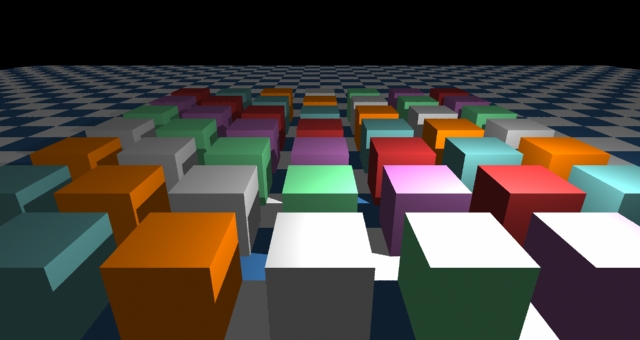
#! /usr/bin/env python
from lightflowPM import *
from math import *
import colorinc
s = scene()
s.lightOn( s.newLight( "point", [ "position", vector3( 5.0, -5.0, 6.0 ), "color", vector3( 300.0, 300.0, 300.0 ) ] ) )
s.lightOn( s.newLight( "ambient", [ "color", vector3( 0.3, 0.3, 0.3 ) ] ) ) #環境光を加える。
plastic = s.newMaterial( "standard",[ "kc", colorinc.Brown,"kd",0.66 ] ) #
plastic2 = s.newMaterial( "standard",[ "kc", colorinc.CadetBlue,"kd",0.66 ] ) #
plastic3 = s.newMaterial( "standard",[ "kc", colorinc.Coral,"kd",0.66 ] ) #
plastic4 = s.newMaterial( "standard",[ "kc", colorinc.VLightGray,"kd",0.66 ] ) #
plastic5 = s.newMaterial( "standard",[ "kc", colorinc.Aquamarine,"kd",0.66 ] ) #
plastic6 = s.newMaterial( "standard",[ "kc", colorinc.BlueViolet,"kd",0.66 ] ) #
#plasticをリスト化した
col=[plastic,plastic2,plastic3,plastic4,plastic5,plastic6]
check_ground=s.newPattern("check",["color",vector3( 0.2, 0.4, 0.6 ),"scale",0.025])
ground=s.newMaterial( "standard",[ "kc", check_ground,"kc",vector3( 1.0, 1.0, 1.0 ),"ka",check_ground ] ) #チェック青と白
#関数定義 ボックスの位置とリストcolのインデックス番号0から5まで
def boxpos(x0,y0,z0,c):
s.materialBegin( col[c] )
s.transformBegin( transform().translation( vector3(x0,y0,z0)))
s.addObject( s.newObject( "box", [ "position",vector3( -1.0, -1.0, -1.0 ),vector3( 1.0, 1.0, 1.0 )] ) )
s.transformEnd()
s.materialEnd()
#Create boxes!!
c=0
cnt=0
for i in range(-9,10,3):
for k in range(-6,13,3):
boxpos(i,k,0,c)
cnt=cnt+1
c=cnt%6
#check模様の地面groundをpatchで作成しています。高さ(z軸)を-1.0にしてぴったり立方体とあわせています。
s.materialBegin( ground )
s.addObject( s.newObject( "patch", [ "points",vector3( -50, -50, -1.0 ),vector3( -50, 50, -1.0 ),vector3( 50, -50, -1.0 ),vector3( 50, 50, -1.0 )] ) )
s.materialEnd()
saver = s.newImager( "tga-saver", [ "file", "box_def5.tga" ] )
s.imagerBegin( saver )
camera = s.newCamera( "pinhole", [ "eye", vector3( 0, -12, 5 ), "aim", vector3( 0, 0, 0 ) ] )
s.imagerEnd()
s.render( camera, 640, 340 )
Lightflowで立方体をランダムに回転配置する
立方体49個並べてZ軸中心に回転させる。乱数を発生させる
import random
モジュールを呼び出す。
関数も回転を入れて書き換える。
乱数でリストの中から数値を取り出すようにした。
rot=random.choice([0,6,15,23,30,45,60,75,88])
立方体なので0から90度以内で変化する。
#関数定義 ボックスの位置とリストcolのインデックス番号0から5まで、Z軸中心回転角度rotを追加
def boxpos(x0,y0,z0,rot,c):
s.materialBegin( col[c] )
s.transformBegin( transform().translation( vector3(x0,y0,z0)))
s.transformBegin( transform().rotationAroundZ( pi*rot/180 ))
s.addObject( s.newObject( "box", [ "position",vector3( -1.0, -1.0, -1.0 ),vector3( 1.0, 1.0, 1.0 )] ) )
s.transformEnd()
s.transformEnd()
s.materialEnd()
#Create boxes!!
c=0
cnt=0
for i in range(-9,10,3):
for k in range(-6,13,3):
rot=random.choice([0,6,15,23,30,45,60,75,88])
boxpos(i,k,0,rot,c)
cnt=cnt+1
c=cnt%6
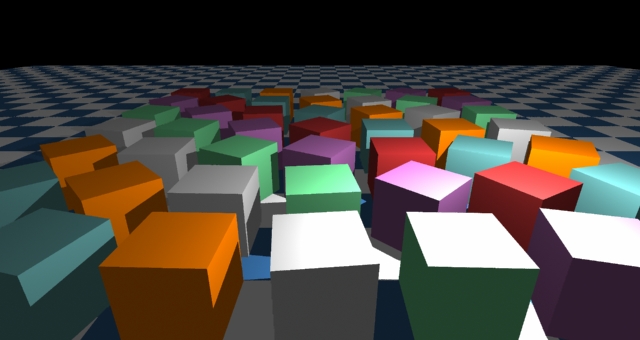
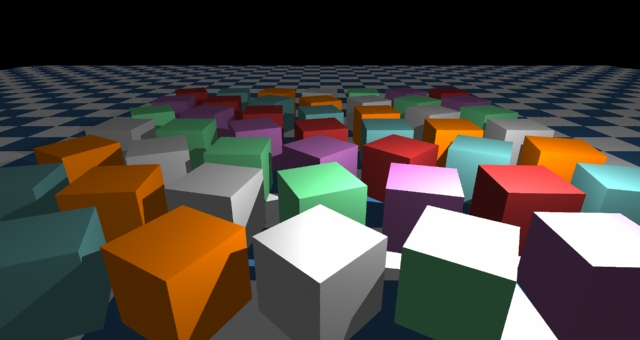
以下は、サンプルファイル参考にしてください。
#! /usr/bin/env python
#box_pos_rot.py
from lightflowPM import *
from math import *
import colorinc
import random
s = scene()
s.lightOn( s.newLight( "point", [ "position", vector3( 5.0, -5.0, 6.0 ), "color", vector3( 300.0, 300.0, 300.0 ) ] ) )
s.lightOn( s.newLight( "ambient", [ "color", vector3( 0.3, 0.3, 0.3 ) ] ) ) #環境光を加える。
plastic = s.newMaterial( "standard",[ "kc", colorinc.Brown,"kd",0.66 ] ) #
plastic2 = s.newMaterial( "standard",[ "kc", colorinc.CadetBlue,"kd",0.66 ] ) #
plastic3 = s.newMaterial( "standard",[ "kc", colorinc.Coral,"kd",0.66 ] ) #
plastic4 = s.newMaterial( "standard",[ "kc", colorinc.VLightGray,"kd",0.66 ] ) #
plastic5 = s.newMaterial( "standard",[ "kc", colorinc.Aquamarine,"kd",0.66 ] ) #
plastic6 = s.newMaterial( "standard",[ "kc", colorinc.BlueViolet,"kd",0.66 ] ) #
#plasticをリスト化した
col=[plastic,plastic2,plastic3,plastic4,plastic5,plastic6]
check_ground=s.newPattern("check",["color",vector3( 0.2, 0.4, 0.6 ),"scale",0.025])
ground=s.newMaterial( "standard",[ "kc", check_ground,"kc",vector3( 1.0, 1.0, 1.0 ),"ka",check_ground ] ) #チェック青と白
#関数定義 ボックスの位置とリストcolのインデックス番号0から5まで、Z軸中心回転角度rotを追加
def boxpos(x0,y0,z0,rot,c):
s.materialBegin( col[c] )
s.transformBegin( transform().translation( vector3(x0,y0,z0)))
s.transformBegin( transform().rotationAroundZ( pi*rot/180 ))
s.addObject( s.newObject( "box", [ "position",vector3( -1.0, -1.0, -1.0 ),vector3( 1.0, 1.0, 1.0 )] ) )
s.transformEnd()
s.transformEnd()
s.materialEnd()
#Create boxes!!
c=0
cnt=0
for i in range(-9,10,3):
for k in range(-6,13,3):
rot=random.choice([0,6,15,23,30,45,60,75,88])
boxpos(i,k,0,rot,c)
cnt=cnt+1
c=cnt%6
#check模様の地面groundをpatchで作成しています。高さ(z軸)を-1.0にしてぴったり立方体とあわせています。
s.materialBegin( ground )
s.addObject( s.newObject( "patch", [ "points",vector3( -50, -50, -1.0 ),vector3( -50, 50, -1.0 ),vector3( 50, -50, -1.0 ),vector3( 50, 50, -1.0 )] ) )
s.materialEnd()
saver = s.newImager( "tga-saver", [ "file", "box_pos_rot.tga" ] )
s.imagerBegin( saver )
camera = s.newCamera( "pinhole", [ "eye", vector3( 0, -12, 5 ), "aim", vector3( 0, 0, 0 ) ] )
s.imagerEnd()
s.render( camera, 640, 340 )
Lightflowで立方体を45度回転配置する
rot=45に指定してしまうと、全部がいっせいに整列します。
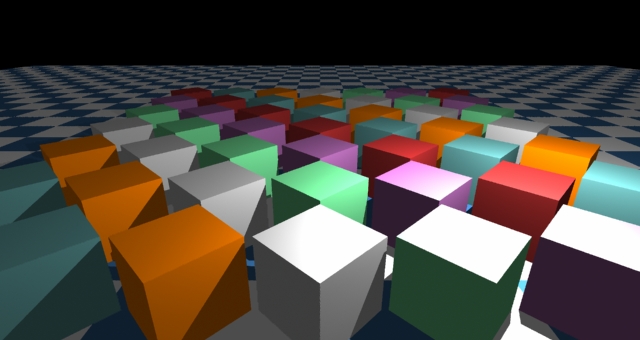
球体の質感1
球体の質感について調整する。
基本質感。
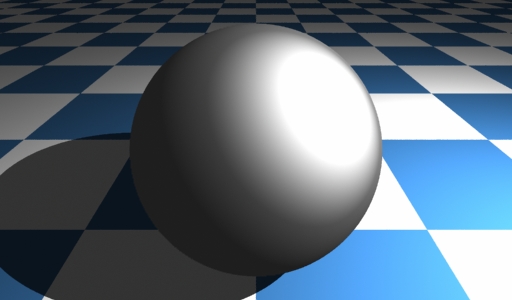
以下はサンプルファイル参考にしてください。
#! /usr/bin/env python
from lightflowPM import *
from math import *
s = scene()
s.lightOn( s.newLight( "point", [ "position", vector3( 5.0, -2.0, 5.0 ), "color", vector3( 300.0, 300.0, 300.0 ) ] ) )
s.lightOn( s.newLight( "ambient", [ "color", vector3( 0.2, 0.2, 0.2 ) ] ) ) #環境光を加える。
plastic = s.newMaterial( "standard",[ "kc", vector3( 0.6, 0.6, 0.6 ),"kd", 0.33 ] )
plastic2 = s.newMaterial( "standard",[ "kc", vector3( 0.6, 0.6, 0.6 ),"kd", 0.33 ] )
plastic3 = s.newMaterial( "standard",[ "kc", vector3( 0.6, 0.6, 0.6 ),"kd", 0.33 ] )
check_ground=s.newPattern("check",["color",vector3( 0.2, 0.4, 0.6),"scale",0.025])
ground=s.newMaterial( "standard",[ "kc", check_ground,"kc",vector3( 1.0, 1.0, 1.0 ),"ka",check_ground ] )
#ground=s.newMaterial( "standard",[ "kc", vector3( 1, 1, 1 ) ] ) #白
s.materialBegin( plastic )
s.addObject( s.newObject( "sphere", [ "radius",1.4] ) )
s.materialEnd()
#地面groundをpatchで作成しています。高さ(z軸)を-1.4にしてぴったり球とあわせています。
s.materialBegin( ground )
s.addObject( s.newObject( "patch", [ "points",vector3( -50, -50, -1.4 ),vector3( -50, 50, -1.4 ),vector3( 50, -50, -1.4 ),vector3( 50, 50, -1.4 )] ) )
s.materialEnd()
saver = s.newImager( "tga-saver", [ "file", "sphere_glass01.tga" ] )
s.imagerBegin( saver )
camera = s.newCamera( "pinhole", [ "eye", vector3( 0, -3, 2 ), "aim", vector3( 0, 0, 0 ) ] )
s.imagerEnd()
s.render( camera, 512, 300 )
球体の質感2
映り込みの設定
"kr",vector3(0.4,0.4,0.4)
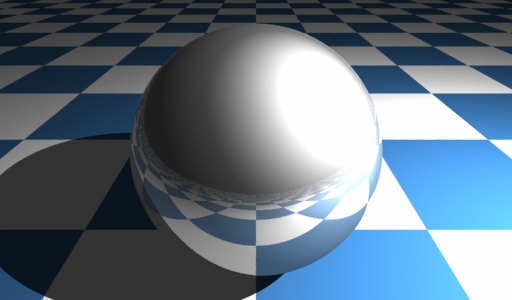
以下のサンプルファイルを参考にしてください。
#! /usr/bin/env python
from lightflowPM import *
from math import *
s = scene()
s.lightOn( s.newLight( "point", [ "position", vector3( 5.0, -2.0, 5.0 ), "color", vector3( 300.0, 300.0, 300.0 ) ] ) )
s.lightOn( s.newLight( "ambient", [ "color", vector3( 0.2, 0.2, 0.2 ) ] ) ) #環境光を加える。
plastic = s.newMaterial( "standard",[ "kc", vector3( 0.6, 0.6, 0.6 ),"kd", 0.33 ,"kr",vector3(0.4,0.4,0.4)] )
plastic2 = s.newMaterial( "standard",[ "kc", vector3( 0.6, 0.6, 0.6 ),"kd", 0.33 ] )
plastic3 = s.newMaterial( "standard",[ "kc", vector3( 0.6, 0.6, 0.6 ),"kd", 0.33 ] )
check_ground=s.newPattern("check",["color",vector3( 0.2, 0.4, 0.6),"scale",0.025])
ground=s.newMaterial( "standard",[ "kc", check_ground,"kc",vector3( 1.0, 1.0, 1.0 ),"ka",check_ground ] )
#ground=s.newMaterial( "standard",[ "kc", vector3( 1, 1, 1 ) ] ) #白
s.materialBegin( plastic )
s.addObject( s.newObject( "sphere", [ "radius",1.4] ) )
s.materialEnd()
#地面groundをpatchで作成しています。高さ(z軸)を-1.4にしてぴったり球とあわせています。
s.materialBegin( ground )
s.addObject( s.newObject( "patch", [ "points",vector3( -50, -50, -1.4 ),vector3( -50, 50, -1.4 ),vector3( 50, -50, -1.4 ),vector3( 50, 50, -1.4 )] ) )
s.materialEnd()
saver = s.newImager( "tga-saver", [ "file", "sphere_glass02.tga" ] )
s.imagerBegin( saver )
camera = s.newCamera( "pinhole", [ "eye", vector3( 0, -3, 2 ), "aim", vector3( 0, 0, 0 ) ] )
s.imagerEnd()
s.render( camera, 512, 300 )
球体の質感3
透明度を加える。
plastic = s.newMaterial( "standard",[ "kc", vector3( 0.2, 0.2, 0.2 ),"kd", 0.01 ,"kr",vector3(0.2,0.2,0.2),"kt",vector3(0.8,0.8,0.8),"IOR",1.12] )
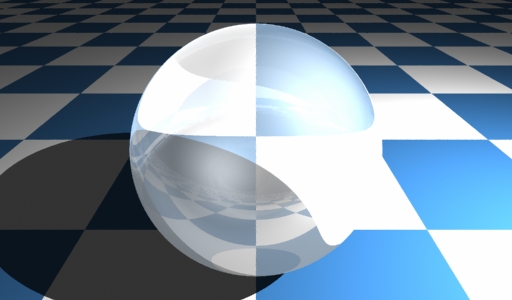
以下のサンプルファイルを参考にしてください。
#! /usr/bin/env python
from lightflowPM import *
from math import *
s = scene()
s.lightOn( s.newLight( "point", [ "position", vector3( 5.0, -2.0, 5.0 ), "color", vector3( 300.0, 300.0, 300.0 ) ] ) )
s.lightOn( s.newLight( "ambient", [ "color", vector3( 0.2, 0.2, 0.2 ) ] ) ) #環境光を加える。
plastic = s.newMaterial( "standard",[ "kc", vector3( 0.2, 0.2, 0.2 ),"kd", 0.01 ,"kr",vector3(0.2,0.2,0.2),"kt",vector3(0.8,0.8,0.8),"IOR",1.12] )
plastic2 = s.newMaterial( "standard",[ "kc", vector3( 0.6, 0.6, 0.6 ),"kd", 0.33 ] )
plastic3 = s.newMaterial( "standard",[ "kc", vector3( 0.6, 0.6, 0.6 ),"kd", 0.33 ] )
check_ground=s.newPattern("check",["color",vector3( 0.2, 0.4, 0.6),"scale",0.025])
ground=s.newMaterial( "standard",[ "kc", check_ground,"kc",vector3( 1.0, 1.0, 1.0 ),"ka",check_ground ] )
#ground=s.newMaterial( "standard",[ "kc", vector3( 1, 1, 1 ) ] ) #白
s.materialBegin( plastic )
s.addObject( s.newObject( "sphere", [ "radius",1.4] ) )
s.materialEnd()
#地面groundをpatchで作成しています。高さ(z軸)を-1.4にしてぴったり球とあわせています。
s.materialBegin( ground )
s.addObject( s.newObject( "patch", [ "points",vector3( -50, -50, -1.4 ),vector3( -50, 50, -1.4 ),vector3( 50, -50, -1.4 ),vector3( 50, 50, -1.4 )] ) )
s.materialEnd()
saver = s.newImager( "tga-saver", [ "file", "sphere_glass03.tga" ] )
s.imagerBegin( saver )
camera = s.newCamera( "pinhole", [ "eye", vector3( 0, -3, 2 ), "aim", vector3( 0, 0, 0 ) ] )
s.imagerEnd()
s.render( camera, 512, 300 )
1/2 >>










